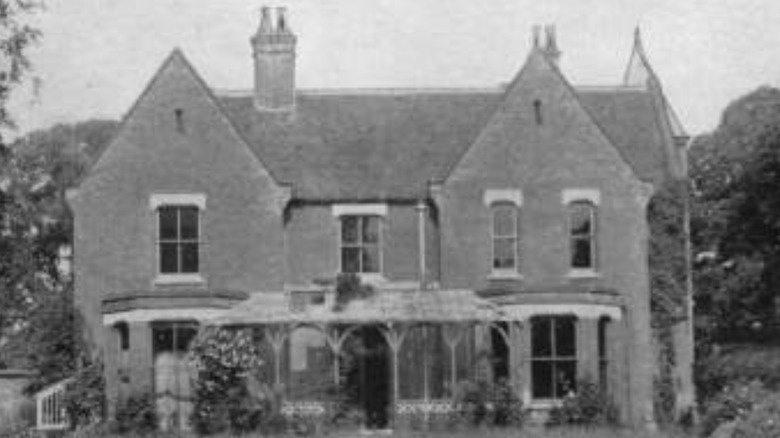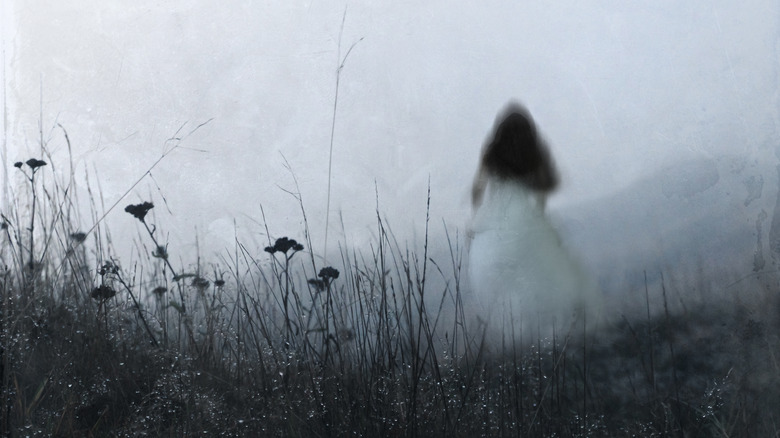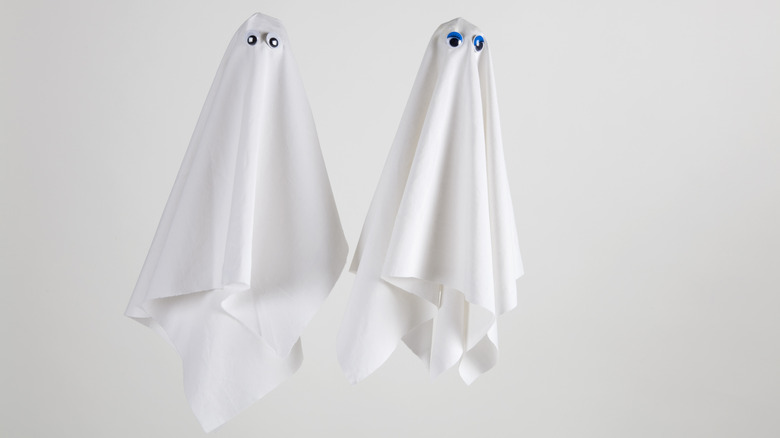Borley Rectory: The Truth About The 'Most Haunted House In England'
Borley Rectory in Essex, England, was originally built in 1862 by Reverend Henry Dawson Bull. Bull was chosen to be the rector/parish priest for the nearby Borley Church just up the road. The rectory was built to house Bull and his family, which eventually grew to 14 children, and as the family grew, so did the Gothic brick house (per The Infographics Show, posted on YouTube). The site where the rectory was built — as do most all places in England — already had quite a reputation: Previously, a Benedictine monk and a nun, each living in buildings near to the eventual rectory, had fallen in love and snuck out at night to see each other. When they decided to elope and run away together, they were caught. The monk was hanged, and the nun was imprisoned and bricked-in alive in the basement of the convent, subsequently suffering a brutal death.
Once Bull and his family were living at the newly-constructed rectory, strange things allegedly started happening immediately. They were said to hear running water inside, even though the house didn't have indoor plumbing. Ethel, one of the children, was said to have heard footsteps and knocking on her door, and was plagued by lack of sleep because of the unexplained sounds. The knocking grew louder over the course of several nights, until poor little Ethel felt a slap on her cheek, and had a red mark to prove it.
'Sixteen Hours of Thrills!'
Though the allegations of strange happenings continued, including a floating, vanishing nun seen on the grounds, the Bull family stayed put, with a younger Henry Bull taking over the position of rector after the father's death in 1892 (via Essex Live). The younger Bull also saw headless ghosts and ghostly horse-drawn carriages, and was said to have a certain fascination with it all.
Reports of specters and phantoms — some harmless, some not — continued through the terms of service of successive rectors in the early 20th century, and culminated in a visit in 1929 by famous paranormal investigator Harry Price, who validated the rumors in local pubs that it was "the most haunted house in England." According to an article in TIME, Price said of his visit, "It was a day to be remembered even by an experienced investigator ... Sixteen hours of thrills!" The house burned down in 1938, but the reports of paranormal sightings didn't stop.
This is truly the stuff that fuels the imaginations of ghost fans.
A Hoax Revealed
But "We Faked the Ghosts of Borley Rectory" by Louis Mayerling, a book released in 2000, threw some pretty serious shade on the whole thing. In an article about the book, The Guardian reported that Mayerling had considered the rectory a second home until it burned down. He said, "I would love to say that there was a grain of truth in it all, but I felt that the book had to be written to reveal the farcical truth about the house — as personally experienced."
Mayerling explained that there were secret passages and servants and even children in on the ruse all throughout the history of the house. Mayerling also said that when the Reverend Lionel Foyster took over in the '30s, that he and his family were struggling financially (as were most people in the '30s), and they figured that keeping the rectory's ghostly mystique alive could only help them. The Foysters had installed a new water heater, Mayerling said, which made loud knocking noises, noises that the couple claimed terrified them. The Foysters also encouraged Mayerling, who was visiting the rectory, to walk the gardens at dusk in a black cape with a turned-up collar when tourists were around, lending to the myth of a headless ghoul damned to roam the grounds forever. However, the story of Borley Rectory is not so cut-and-dry.
'It still makes me feel rather shaken'
In that same book, Mayerling said that there was one incident that even he could never explain. On Easter in 1935, the famous Irish playwright George Bernard Shaw, Sir Montagu Norman (Governor of the Bank of England), Bernard Spilsbury (criminal forensic scientist), and Marianne Foyster, the pastor's wife, attended a séance at Borley. Mayerling said the group sat in silence in a dimly lit cellar on the grounds at midnight, when all of a sudden, they heard bells in the kitchen (set up to detect any intruders) clanging loudly, all together. There was no one up there, and no way to fake such a thing.
"Norman jumped up and then there was a lightning strike of silver-blue light which appeared to implode from all walls and the ceiling of the cellars and then there was a dead silence," Mayerling told The Guardian in 2000. "Shaw had been in the process of pushing a box of matches diagonally across the table and Norman was half off his chair in a turning position, but every member of the séance was struck with an instant paralysis which lasted about five seconds." Mayerling said that he was temporarily blinded, but later regained sight in one eye, and Shaw and Norman refused to stay the night. "I can't explain that occurrence and, to be honest, it still makes me feel rather shaken. The rest of the hauntings were, without exception, the most successful hoax of the age, but that still sets my spine tingling." Sweet dreams!



